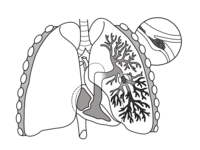
Photo from wikipedia
Pulmonary embolism is a potentially life-threatening disease, which can present with varying severity. Based on an emergency risk stratification, the initial treatment strategy should be chosen without delay. While patients with… Click to show full abstract
Pulmonary embolism is a potentially life-threatening disease, which can present with varying severity. Based on an emergency risk stratification, the initial treatment strategy should be chosen without delay. While patients with a low mortality risk can be treated in an outpatient setting, patients at high risk should proceed to immediate recanalization by thrombolysis or thrombectomy. Systemic thrombolysis is the first line therapy in the absence of contraindications. The dosing (low versus full dose) and application (systemic versus local via a catheter) of alteplase, the most frequently used agent, is the subject of a number of current studies with the goal to reduce the risk of bleeding. In the case of contraindications for systemic thrombolysis surgical or alternatively, interventional thrombectomy should be performed. This article discusses these procedures in the light of the currently available literature.
Journal Title: Herz
Year Published: 2019
Link to full text (if available)
Share on Social Media: Sign Up to like & get
recommendations!